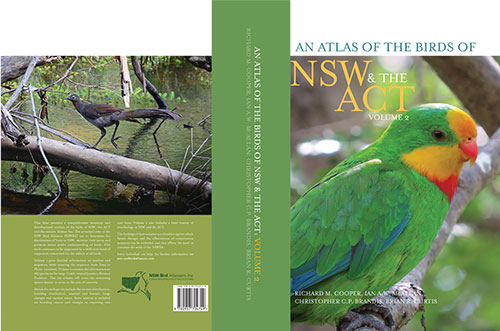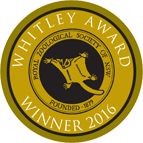AN ATLAS OF THE BIRDS OF NSW & THE ACT
The principal aims of the NSW Bird Atlassers (NSWBA) are to determine the distribution of birds in NSW, monitor their status and promote better public understanding of birds.
An Atlas of the Birds of NSW & the ACT presents the results of long-term data collection and analysis as a baseline against which future changes and the effectiveness of conservation measures can be evaluated and affirms the need to continue the work of the NSWBA.
An Atlas of the Birds of NSW & the ACT is a comprehensive inventory and distributional analysis on the species of birds occurring within NSW, the ACT and the western Tasman Sea. For each species we summarize what is known about the occurrence, distribution, breeding biology, movements, history and current status. A Guide to Bird Habitats in New South Wales covers specific habitats referred to in Atlas volumes can be found in this NSWBA publication.
Prices |
Members | Non-Members |
| Price for Volumes 1,2 & 3 | $ 310 | $ 390 |
| Postage | NSW $ 60 Aust. $ 70 |
NSW $ 60 Aust. $ 70 |
| Volume 3 | $120 | $170 (rrp) |
| Postage | $ 25 | $ 25 |
| Volume 2 | $ 95 | $135 (rrp) |
| Postage | $ 25 | $ 25 |
| Volume 1 | $ 95 | $135 (rrp) |
| Postage | $ 25 | $ 25 |
| A Guide to Bird Habitats in New South Wales – Postage free | $ 32 | $ 40 (rrp) |
Become a member and get immediate discount club prices.
Direct Deposit Details:
Account Name: NSW Bird Atlassers Inc
Financial Institution NAB (National Australia Bank) BSB: 082-887
Account Number 779634356
It is important that any deposits include ” Atlas, Vol No. & your surname”.
You MUST also contact our treasurer with your full name and delivery details.
PO Box 717
Woogoolga NSW 2456
Phone 02 6654 8447
or email treasurer@nswbirdatlassers.org.au
Payment via Cheque:
Users can also send a cheque to:
The Treasurer NSW Bird Atlassers
PO Box 717
Woogoolga NSW 2456
Remember to supply your full name and delivery address.
Please note titles cannot be posted until the treasurer receives a direct deposit or your cheque clears.
Volume 3

Volume 3 is now available. The Volume contains 776 pages and covers resident, introduced and migrant species from the Eastern Spinebill to the Common Greenfinch, details of several birds now considered to be NSW regulars and of the Lord Howe Island endemic or near-endemic species and a comprehensive listing of all verifiable records of those birds that are known to be vagrants to NSW.
This is the final volume of what has been an undeniably mammoth task – thanks to the contributions by members of ~6 million data entries and to the authors who have dedicated days, months and years of their lives with dedication for its fruition.
By way of recognition that the information in this Atlas is not available in Field Guides or similar publications, Volume 2 received the Whitley Award for Best Zoological Resource. The data-set is the longest ongoing set collected with consistent methodology in NSW and users can have confidence that the observed trends are real.
For each species, there are maps, graphs and tables summarising the reported distribution, breeding distribution, seasonal and historic range changes, together with monthly breeding records and monthly and annual reporting rates. The text provides a summary of what is known about the occurrence, distribution, breeding biology, movements, history and current status of each species.
The authors have analysed an extensive quantitative data-set to identify trends which should prove invaluable in developing environmental policy to minimise future planning impacts, aid more cost-effective research, conservation and management programs and provide a baseline against which future changes and the effectiveness of conservation measures can be evaluated.
List of species in Vol. 3 click here
Volume 2

Volume 2, continues the same style and layout and deals with the resident and regular migrants from the Comb-crested Jacana to the Striated Pardalote.
Included in this volume is a history of ornithology in New South Wales and the Australian Capital Territory covering from pre-1770 to the present.
Volume two of the complete Atlas which compiles a wealth of data, information and knowledge collected by NSW Bird Atlasser members and the authors.
The publication includes maps and information on reporting rates, range changes and trends in bird populations within NSW.
For each bird details include maps, graphs, tables and text on current distribution, breeding, seasonal and historical change and assessment of current status.
This information thus provides a better understanding of the status and needs of each species and where to best concentrate conservation management efforts as well as a baseline against which future studies, environmental trends and conservation efforts can be measured.
For a list of species in Vol. 2 click here
Volume 1

Volume 1 presents information on the 183 species of resident and migrant birds from the Emu to the Plains-wanderer.
It includes a history of collection of bird distribution ornithology in NSW and the ACT, collection methods and scale, sources of data, statistics, the geography and climate of NSW and the ACT, habitats and threatening processes in NSW and details of the biogreographic analysis used in this Atlas.
Volume one of the complete Atlas which compiles a wealth of data, information and knowledge collected by NSW Bird Atlasser members and the authors. The Publication includes maps and information on reporting rates, range changes and trends in bird populations within NSW.
For a list of species in Vol. 1 click here

Great companion book for your Atlas
A Guide to Bird Habitats in New South Wales
R.M. Cooper & I.A.W. McAllan
This publication endeavours to facilitate our aims by providing a means for people to better identify and appreciate the habitats of birds. This, in turn, should enable us to achieve the goal of linking bird distribution and habitat preferences while, at the same time, we hope it will help to conserve habitats and the birds and other animals associated with those habitats.
Quote from Vol 1. Page 23:
“The NSWBA focus has been on the dominant features of the habitats rather than fine detail.
Specific habitats referred to in this Atlas can be found in the NSWBA publication.”
210mm x 150mm with 160 pages, 78 habitats types fully described; many with illustrations, 2 plates of bark types, glossary, appendix of botanical names, use of the guide and understanding the impact of people on birds.
The NSWBA is supported by a dedicated band of supporters concerned for the welfare of all birds.










